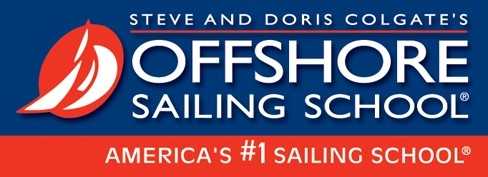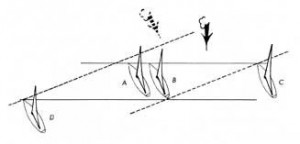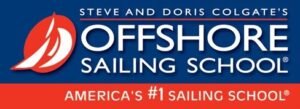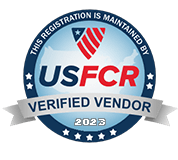More can be gained or lost in one healthy wind shift that can usually be made up by any amount of boat speed or superior sailing. But beginning racing skippers are often so concerned about whether their boat is sailing faster than the one next to them that they neglect to consider the effect of wind shifts. They fail to recognize them and don’t know how to handle them properly.
However, discussing any wind shift with skippers who can’t steer within 10° of a close-hauled course (because they’re too worried about other boats) is useless. Half the time, the boat is either luffing or hard and a shift is not noticed even if it is 20°! So a basic premise of utilizing these sailboat racing tactics is that one must be able to sail the boat well enough to know that a luff can indicate a large wind shift, and is not caused by erratic steering.
Landmarks
How do we determine a shift? Many people use landmarks, but this is only good on short runs, in fact only for one tack. Once a boat has tacked twice, the angle to the landmark is different and is no longer reliable for gauging sailing wind shifts.
Compass
For boats having compasses, a crewmember should continuously call the compass readings. A skipper can get confused about just which way the wind has shifted. As a memory aid, make two assumptions:Figure 134-136
A boat on starboard tack is superior to a boat on port tack, and a lift is better than a header. On the starboard tack, the higher the numbers (indicating a lift), the better off you are, but on the port tack the higher numbers are bad. This may be a little oblique but it can tend to eliminate confusion. Thus, if you are sailing 275° on starboard tack and a short time later the crew call out 280°, you have been lifted. On port tack you have, of course, taken a header.
Relative Positions
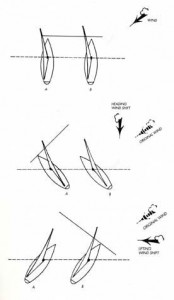 A third way to determine sailing wind shifts is by your relative position to other boats. This sailboat racing tactic is used most often on single-handed small boats, that either don’t carry compasses or are bouncing around too much for them to be dependable. Of course, the skipper of a single-handed boat doesn’t have a crew to read compass readings to him.
A third way to determine sailing wind shifts is by your relative position to other boats. This sailboat racing tactic is used most often on single-handed small boats, that either don’t carry compasses or are bouncing around too much for them to be dependable. Of course, the skipper of a single-handed boat doesn’t have a crew to read compass readings to him.
In Figure 134, the two boats, A and B, are abeam of each other. In Figure 135, the wind has headed the boats and A has “shot” ahead, even though the distance between the boats hasn’t changed (note the dotted line through the mast). In Figure 136, both have been lifted and B is well ahead of A.
If you’re sailing A in Figure 135, it’s quite easy to attribute the sudden lead to superior helmsmanship, some extra little trim on the mainsheet, or a minor adjustment to the traveler. In fact, anything that suits the ego will do except the real reason that you’ve both been headed and you ought to tack.
Tacking in Headers
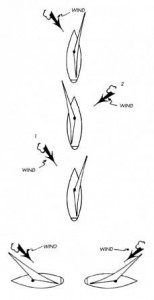 Why should you tack in a header? The classic description of why one tacks in headers can be shown by exaggeration. Imagine a wind that’s shifting back and forth from NE to NW. The boat in Figure 137 tacks on headers and is on port tack in the NW wind. The boat in Figure 138 tacks on lifts. They are on starboard tack in the NW wind and port in the NE wind. One can see that the boat which tacks in headers is sailing straight up the course toward the windward mark while the other is sailing back and forth across the course. This never happens to such extremes, but the same occurs in small sailing wind shifts with small gains and losses.
Why should you tack in a header? The classic description of why one tacks in headers can be shown by exaggeration. Imagine a wind that’s shifting back and forth from NE to NW. The boat in Figure 137 tacks on headers and is on port tack in the NW wind. The boat in Figure 138 tacks on lifts. They are on starboard tack in the NW wind and port in the NE wind. One can see that the boat which tacks in headers is sailing straight up the course toward the windward mark while the other is sailing back and forth across the course. This never happens to such extremes, but the same occurs in small sailing wind shifts with small gains and losses.
For this reason, given the choice between the two boats shown in Figure 134, a novice skipper would usually elect to be on boat B. Not only are they to windward of the other boat, but if a lift comes, they will go well ahead of A. This is called being on the inside of a lift.
Continual Lifts
The only hitch in this sailboat racing tactic is that if the wind continues to shift in the same direction (see Figure 139), every time the skipper cannot lay it. Most racing skippers call this “sailing the great circle route.” Instead of gloating over how they are putting it to boat A (see Figure 136), the crew of boat B should be concerned that this may be a permanent shift to the right (see Figure 139). Perhaps they should tack when they get further lifted at point B. If they had tacked at point B, taken their beating (sailing in a header), and tacked again at point C when they were headed further, they would have come out far better in the long run. It’s this very problem that makes boat A’s position (in Figure 134) slightly superior. If permanently lifted, they are more apt to tack away from B and get on the proper side of the shift. If headed, A is ahead of B, remains ahead after tacking, and increases its lead as the wind lifts A up to the mark.
Equal Position Lines
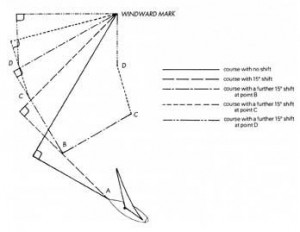 Boats are even with eachother upwind if they are all on a line perpendicular to the wind direction the “line of equal position.” In Figure 140, boats A, B, and C are all equally upwind. If either A or B tacked, they would meet C bow to bow. None is ahead of the others. Boat D, however, is tail-end Charlie, well behind and to leeward. Along comes a backing wind shift (see dotted lines). If lines of equal position are drawn perpendicular to the new wind direction, we see that tail-end Charlie, boat D, now leads the fleet, with boat A in second place, B third, and C running a poor last. Therefore, if you expect a header, for some meteorological or geographical reason, always sail to the side of the course it is expected to come from.
Boats are even with eachother upwind if they are all on a line perpendicular to the wind direction the “line of equal position.” In Figure 140, boats A, B, and C are all equally upwind. If either A or B tacked, they would meet C bow to bow. None is ahead of the others. Boat D, however, is tail-end Charlie, well behind and to leeward. Along comes a backing wind shift (see dotted lines). If lines of equal position are drawn perpendicular to the new wind direction, we see that tail-end Charlie, boat D, now leads the fleet, with boat A in second place, B third, and C running a poor last. Therefore, if you expect a header, for some meteorological or geographical reason, always sail to the side of the course it is expected to come from.
Reprinted from Fundamentals of Sailing, Cruising & Racing By Steve Colgate; Published by W. W. Norton & Company
About Fundamentals of Sailing, Cruising & Racing by Steve Colgate:
America’s most experienced and renowned sailing instructor has put down in this volume all he knows about this subject. And he has done it in a way that reflects years of searching for and finding the best way to teach sailing. The result is an incomparable book for anyone who wants to become an expert sailor. A complete line of books are available in bookstores and online at all key book vendors. Or call 800-221-4326 or email sail@offshore-sailing.com.
